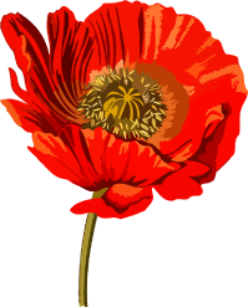There can be few people anywhere in the world these days completely unacquainted with the life and times of Harry Potter Esq., the young wizard hero of JK Rowling’s stupendous epic. Of course, one thing that influences events on virtually every page of these books is the use of magic. An up and coming young wizard like Harry needs to be instructed in ancient magical practices, and so has to spend several years at Hogwarts Academy, an institution which, in many important respects, bears an uncanny resemblance to numerous British boarding schools. I spent most of my youth attending a couple of these institutions, although unfortunately magic wasn’t on the curriculum. Nevertheless, the look and feel of Hogwarts conjured up many memories of boarding school.
One of the most important classes Harry has to attend is herbology, taught by Professor Pomona Sprout. Obviously, if you are a wizard, you must know about different types of magical plants, as these are the raw materials you will need for mixing potions of different types. It’s not clear that Harry Potter is all that dedicated to the study of herbology, his contemporary Neville Longbottom being the real star of the class. A careful examination of JK Rowling’s text reveals that a very large number of magical plants and their effects are mentioned as one traverses the 7 volumes of the story. From the muggle’s point of view, one is obviously interested in knowing whether such plants really exist in our subluminary non-wizarding world. The answer is that many of them do – sort of. In some cases, it requires a bit of imagination to completely identify what Prof. Sprout and her class are studying. In other instances, the plants and their properties are easily identifiable. This is the first of an ongoing series in which the nature some of these plants will be explored.
One of the most memorable scenes in the books and the associated movies concerns a herbology class in which Harry and his friends are introduced to a plant known as a mandrake. In Harry Potter and the Chamber of Secrets, the class begins with a lecture on cultivating mandrakes, starting with a demonstration as to how to unearth them for the purpose of repotting.
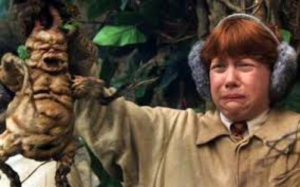
But as we then learn, “Instead of roots, a small, muddy, and extremely ugly baby popped out of the earth (Fig 1). The leaves were growing right out of his head.” Professor Sprout tells her students that the babies emit screams when they are pulled from the ground that are so piercing that they can have a severely incapacitating or even deadly effect. But what is the truth of the matter? As things turn out, in this instance, we are dealing with a plant that seems to have many unusual properties, both magical and otherwise.
There is indeed a plant which is known in the muggle world as a mandrake. The official name of the plant is mandragora officinarum, one of several members of the mandragora genus. Mandrakes are members of the large Nightshade (Solanaceae) family which also contains plants such as the deadly nightshade and tobacco, as well as things like tomatoes and peppers. Mandrakes are perennial plants. Their stems are short so they grow close to the ground as a rosette of leaves. However, one of the most interesting parts of the plant is under the ground –a long
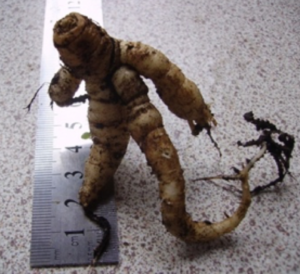
white taproot that looks something like a parsnip or carrot (Fig. 2a). As we shall see, this taproot often bifurcates to form two “legs” giving it a somewhat humanoid appearance. After fertilization mandrakes produce yellow or orange fruit which look like baby tomatoes. Mandragora officinarum is most commonly found growing along the Mediterranean from Portugal all the way to the Levant.
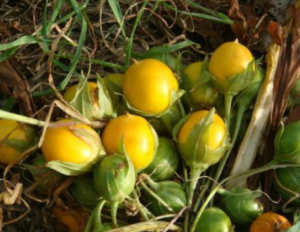
There is an extensive folklore associated with mandrakes. Stories about their magical properties can be found as early as the Old Testament where they are mentioned several times. As it says in the Song of Songs, for example- “The mandrakes give a fragrance, and at our gates are all manner of pleasant fruits, new and old, which I have laid up for you, O my beloved.”
However, the most famous biblical story about mandrakes concerns its use as an aphrodisiac and aid to fertility in the tale of Rachel and Leah, two sisters who were both wives of Jacob. The relationship between the two sisters and Jacob was very different. Rachel was beloved by Jacob but wasn’t able to bear him children, whereas Leah was “despised” but she and Jacob had many children together. The story begins during the summer wheat harvest: “And Reuben went out during the harvest and found mandrakes in the field, and he brought them to his mother Leah…” (Genesis 30:14). Reuben does this in order to renew his mother’s
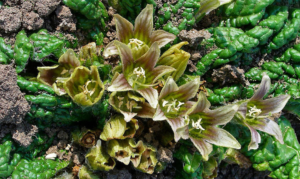
fertility which was her greatest asset in the eyes of her husband. Rachel, who is insanely jealous of her sister’s ability to bear children gives Jacob an ultimatum, “Give me children, or else I will die,”. Rachel realizes that the mandrakes Reuben has found might solve her fertility problem and begs her sister to give them to her. Leah is furious: “Is it not enough that you have taken my husband, now you would take the mandrakes from my son as well?” (Genesis 30:14). Rachel, however, knows exactly what her sister would accept in exchange for the mandrakes. As an offer she says “tonight he (Jacob) will sleep with you in exchange for your son’s mandrakes” (Genesis 30:15). Leah is ecstatic and when she next encounters Jacob she tells him that “I have paid the payment for you with my son’s mandrakes” (Genesis 30:16). Subsequently, a fifth son is born and Leah names him Issachar because “the Lord has given me my payment (s’chari)” (Genesis 30:18). Ironically, Rachel’s use of the mandrakes worked eventually, but it took a while. Her son, Joseph, was born only when “the Lord remembered Rachel and opened her womb” (Genesis 30:22), which was only after Leah bore not only Issachar but also two more children – a son, Zevulun, and a daughter, Dina.
Based on ancient stories such as this, mandrakes subsequently became widely used as a charm for increasing fertility. The long taproot of the plant, which on many occasions has a somewhat human form-it could be regarded as male or female depending on its exact features-was sometimes artificially enhanced to make it look even more humanoid. Women would place these charms under their pillows or wear them around their necks. In countries like England ,where genuine mandrakes do not grow, they had to be imported. Otherwise people would use other roots such as those from parsnips or briony and pass them off as mandrakes.
And it was not only with respect to fertility that mandrakes were said to have magical properties. There were stories associated with the entire ritual of digging them up in the first place. As in Harry Potter’s adventure, it was said that mandrakes made such a horrible screeching sound that it would kill whoever tried to dig it up. Shakespeare refers to this legend in Henry VI (Act III, Scene 2) where Suffolk says:
‘Would curses kill as doth the mandrake’s groan
I would invent as bitter searching terms
As curst, as harsh and horrible to hear.’
In Harry Potter, everybody has to wear earmuffs to protect them from screeching induced death. Another similar story that developed was that the mandrake was possessed by a devil and so the very act of pulling out of the ground would be fatal. It is therefore not surprising that in medieval times great precautions were taken if you wanted to dig up a mandrake. One way of doing it safely was as follows. First take your sword and inscribe three circles on the ground with it while walking around the mandrake. Then take a hungry dog with a string around its neck and tie the other end of the string around the mandrake. You would then stand a safe distance away with your ears plugged up and wave a juicy steak at the dog. The dog would then attempt to run after the steak pulling the mandrake out of the ground as it did so (Fig 3).
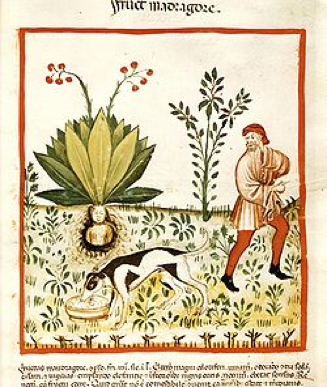
Another legend that grew up around the mandrake, especially in Germany, was that the plant liked to grow underneath gallows. In particular, it was thought that when a victim was hanged he would often urinate or ejaculate and the urine or sperm would be absorbed by the earth beneath the gallows making it a suitable spot for “the little gallows man” to grow.
By the time we get to the 17th century modern science was starting to develop as a method for understanding the world and how things worked. Led by the works of great philosophers such as Sir Francis Bacon, a new methodology based on the collection of evidence, the testing of hypotheses and the use of inductive logical reasoning was employed as a way of making sense of the natural world. Sir Thomas Browne, perhaps the greatest of all science writers, employed this kind of thinking in his great encyclopedia entitled “Pseudodoxia Epidemica or Enquiries into very many received tenets and commonly presumed truths, usually simply known as “Pseudodoxia Epidemica” or “Vulgar Errors”. In this work Browne examined many widely held views on a variety of topics that he considered to be erroneous. In a chapter entitled “Of sundry Tenets concerning Vegetables or Plants, which examined, prove either false or dubious.”, he critically evaluated the diverse legends about mandrakes. Browne begins as follows-“Many mola’s and false conceptions there are of Mandrakes, the first from great Antiquity, conceiveth the Root thereof resembleth the shape of Man; which is a conceit not to be made out by ordinary inspection, or any other eyes, then such as regarding the Clouds, behold them in shapes conformable to pre-apprehensions. Now whatever encouraged the first invention, there have not been wanting many ways of its promotion. The first a Catachrestical and far derived similitude it holds with Man; that is, in a bifurcation or division of the Root into two parts, which some are content to call Thighs; whereas notwithstanding they are oft-times three, and when but two, commonly so complicated and crossed, that men for this deceit are fain to affect their design in other plants; And as fair a resemblance is often found in Carrots, Parsnips, Briony, and many others. There are, I confess, divers Plants which carry about them not only the shape of parts, but also of whole Animals, but surely not all thereof, unto whom this conformity is imputed. Whoever shall peruse the signatures of Crollius, or rather the Phytognomy of Porta, and strictly observe how vegetable Realities are commonly forced into Animal Representations, may easily perceive in very many, the semblance is but postulatory, and must have a more assimilating phansie then mine to make good many thereof.”
Browne goes on to demolish the idea that mandrakes grow under gallows and, as far as making a shrieking noise is concerned, he says-“The third affirmeth the roots of Mandrakes do make a noise, or give a shriek upon eradication; which is indeed ridiculous, and false below confute: arising perhaps from a small and stridulous noise, which being firmly rooted, it maketh upon divulsion of parts. A slender foundation for such a vast conception: for such a noise we sometime observe in other Plants, in Parsenips, Liquorish, Eringium, Flags, and others.”
And, finally, he doesn’t believe that pulling a mandrake from the ground could really be dangerous-“The last concerneth the danger ensuing, That there follows an hazard of life to them that pull it up, that some evil fate pursues them, and they live not very long after. Therefore the attempt hereof among the Ancients, was not in ordinary way, but as Pliny informeth, when they intended to take up the root of this Plant, they took the wind thereof, and with a sword describing three circles about it, they digged it up, looking toward the west. A conceit not only injurious unto truth, and confutable by daily experience, but somewhat derogatory unto the providence of God; that is, not only to impose so destructive a quality on any Plant, but to conceive a Vegetable, whose parts are useful unto many, should in the only taking up prove mortal unto any. To think he suffereth the poison of Nubia to be gathered, Napellus, Aconite, and Thora, to be eradicated, yet this not to be moved. That he permitteth Arsenick and mineral poisons to be forced from the bowels of the Earth, yet not this from the surface thereof. This were to introduce a second forbidden fruit, and inhance the first malediction, making it not only mortal for Adam to taste the one, but capital unto his posterity to eradicate or dig up the other.”
So, much for the magical mandrake!
Although tales as to the magical properties of mandrakes failed the test of time, parallel stories as to its alchemical and pharmacological properties proved to have a much better foundation in fact. Here again stories about the use of mandrakes to make medical potions go back to ancient times. Once again reference to such uses can be found in Shakespeare-
“Give me to drink mandragora,
That I might sleep out this great gap of time
My Antony is away.”
(Anthony and Cleopatra Act I, Sc. 5)
“Not poppy, nor mandragora,
Nor all the drowsy syrups of the world,
Shall ever medicine thee to that sweet sleep
Which thou owdst yesterday.”
(Othello Act III, Sc. 3)
“Were such things here as we do speak about?
Or have we eaten of the insane root
That takes the reason prisoner?
(Macbeth Act I, Sc. 3)”
In addition to its apparent magical properties suggested by its shape, the ancients also knew that consumption of mandrake roots or fruits could produce profound psychological and other effects. These could range from sleepiness and delirium, to coma and death if the dose was high enough. As far as its medical indications are concerned the mandrake is mentioned in the Ebers papyrus, an extraordinary Egyptian scroll composed at least as long ago as 1500 BC, which discusses many interesting aspects of medicine. Mandrakes are suggested in the papyrus as being beneficial for treating intestinal worms. Ancient Greek doctor scientists including Hippocrates, Aristotle and Theophrastus all commented on the potential medical properties of mandrakes. They noted, in particular, its ability to produce delirium, amnesia and sleep and attempted to find ways of controlling the dosage for specific purposes including the treatment of insomnia and depression. Later famous Greek doctors including Dioscorides, who in 78AD wrote the most famous medical primer of the ancient world, his De Materia Medica, which touched on the properties of some 500 medicinal plants, included the use of mandrakes for numerous purposes including insomnia. Somewhat later the influential Greek/Roman doctor Aelius Galen also employed mandrakes as a constituent of many of his complex medicines known as “galenicals”.
Over the years it was observed that the medical effects of mandrakes could also be produced by other plants, all of which turn out to be related members of the Solanaceae family. These plants include black henbane, deadly nightshade and jimsonweed (aka Datura, and many other names), suggesting, from our modern perspective, that they may all contain the same or similar active chemical substances (Fig 4).
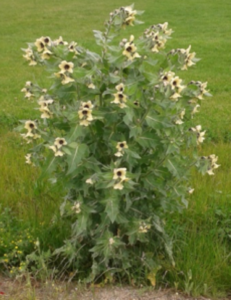
All of these plants played an important role in the practice witchcraft which which became common during the Middle Ages. The existence of witches, women who could manipulate other people through the use of magic, was something that was widely accepted at the time. There are many records of famous witch hunts over the years and these peaked between the 13th and 17th centuries. Certain specific practices are normally associated with witchcraft such as dancing naked in the woods. Another, of course, is the fact that witches and their animal familiars could fly through the air on their broomsticks. It seems likely that plants such as mandrakes, deadly nightshade and henbane played a central role in producing these effects. The practitioners of witchcraft made the observation that it was possible to extract the active chemicals made by these plants into oils, waxes and creams that could then be rubbed on to the skin, particularly areas such as the armpits and genitals. Other plants that contain active chemicals such as hemlock and opium were also frequently included. When this was done the chemicals were easily absorbed through the skin into the blood stream producing delirium, sleep and vivid dreams. Interestingly the dreams produced when people were incapacitated in this way were often reported to be of flying or dancing, which presumably played into the entire mythology suggesting that witches could fly. This is something that has been reproduced by modern day scientists who have made ointments based on ancient recipes and tried them out on themselves experiencing vivid dreams of flying and other extraordinary events. There were no reports, however, of the scientists involved actually mounting broomsticks and streaking through the skies.
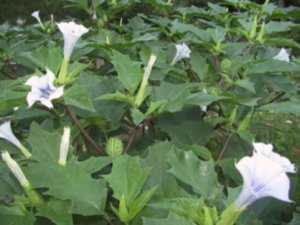
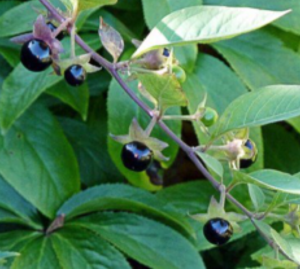
At the same time that these plants were being employed for things like witchcraft they also begun to find a genuine place as therapeutic agents. Here is one description from the 14th century of the use of such a cream to put somebody into a comatose state as a preparation for surgery -“The juice of henbane, mandragora, hemlock, lettuce, black and white poppy with sufficient lard –anoint the forehead, the pulses, the temples, the armpits, the palms of the hands, and the soles of the feet, and immediately the victim will sleep so soundly that he will not feel any cutting “. Doctors would sometimes use a preparation in which plant extracts would be absorbed into a sponge. When hot water was added the sponge could be held under the nose of a patient prior to surgery and the fumes would put the patient into a stupor. The ability to do this enabled doctors to carry out some primitive forms of surgery while the patients were stupefied. In other words, the “soporific sponge” represented a type of anesthesia long before a really scientific approach to the subject was developed.
The middle of the 19th century was really a tremendously exciting time in the development of organic chemistry. As far back as 1727 the Dutch chemist Herman Boerhaave had isolated a substance from human urine which he named urea. As this came from a “natural source” it was assumed that it was organic and therefore had entirely separate properties from inorganic materials that came from non living sources. However, in 1828 the chemist Friedrich Wohler observed that he could produce genuine urea by reacting together silver cyanate with ammonium chloride, two inorganic materials. Some years later the organic molecule acetic acid was similarly prepared from inorganic precursors. In other words, organic chemicals derived from natural sources could be made from chemicals that were not obtained from living organisms. Thus, it was gradually concluded that organic chemistry was just another branch of chemistry and that organic molecules could be artificially synthesized without there having to be any natural intermediate such as a plant or animal.
Advances in organic chemistry during the 19th century enabled the isolation and synthesis of an increasing number of natural products. These techniques were eventually applied to deadly nightshade (Atropa Belladonna) and, in 1831, two German pharmacists named Heinrich Mein and Philipp Geiger purified and crystallized an alkaloid from the roots of the plant which they subsequently named atropine. Geiger gave some of his purified crystals to the famous chemist Justus von Liebig for chemical analysis. Liebig determined that the atomic composition of the substance was C17H23NO3. What this formula represents to a chemist is the number of atoms of each type present in 1 molecule of atropine- 17 carbon atoms,23 hydrogen atoms, one nitrogen atom and three oxygen atoms. This is important information. However, it doesn’t tell you the structure of the molecule which refers to how these atoms are juxtaposed to one other in space producing a unique shape. It’s like saying a house has so many bricks but that doesn’t tell you how the bricks are arranged and what the house actually looks like. In the case of atropine this goal wasn’t ultimately achieved until 1901 when Richard Willstatter managed to break the molecule down into its component parts and then put it back together again-that is to achieve its de novo synthesis from its constituent parts. At the time this was a considerable achievement and Willstatter received the Nobel Prize for this and related efforts.

As things turned out atropine was not exactly what it seemed to be. The active material in A Belladonna is actually a chemical called hyoscyamine. The interesting thing about this molecule is that it can exist in two forms which are the mirror images of each other. This is just like the situation with respect to your hands. Take a look at them. They are exactly the same shape but you can’t lay one on top of the other because they are mirror images. The type of hyoscyamine that exists in the plant is called L-hyoscyamine. During isolation from the plant some of it flips to form its mirror image called D-hyoscyamine and so “atropine” is actually a mixture of the two which we can call DL–hyoscyamine. Chemists call the two forms “stereoisomers”. Here’s how hyoscyamine looks in its two mirror image forms (Fig 5).
Around the same time another group of scientists were investigating black henbane and isolated a molecule which they named hyoscine. This molecule turned out to look a lot like atropine or hyoscyamine .If you look closely you can see that hyoscine has one extra oxygen atom and indeed a plant like henbane makes both hyoscine and hyoscyamine. Around the same time hyoscine was also isolated from another Solanaceous plant
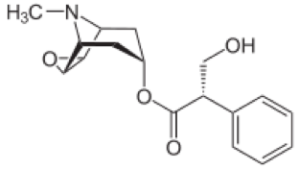
known as Scoplia Carniolica and was named scopolamine. In fact, the name scopolamine, rather than hyoscine, is more commonly used for the drug today. If you look carefully at the structures of hyoscine and hyoscyamine you can see that these molecules really consist of two parts. The part of the molecule containing the nitrogen atom is known as a “tropane” group and so natural products that contain it are known as “tropane alkaloids”. When these purified substances are administered to humans or animals they precisely mimic the effects previously observed using crude plant extracts. Because of this, we know that they are indeed the substances responsible for the effects of the plants observed since antiquity. Jimsonweed, henbane, deadly nightshade and mandrake, as well as many other related species, all make atropine and scopolamine in varying amounts depending on many factors including the species in question, its growing conditions and its age.
But how do these substances exert their effects? This question was answered in the early part of the 20th century when scientists solved the problem of how nerve cells send messages to each other to control their activity. It was discovered that nerve cells secrete chemical messages called neurotransmitters which carry information from one cell to another or from a nerve cell to a muscle, organ or gland. The first of these molecular messengers to be identified was called acetylcholine and many important nerves in the brain (central nervous system) or the peripheral nervous system use it as their neurotransmitter. When acetylcholine delivers its message to another cell it does so by acting on a large protein molecule called a receptor. There are two types of receptors that acetylcholine can activate known as nicotinic or muscarinic, named after nicotine and muscarine two drugs that can specifically activate each receptor type. Other types of drugs can block these receptors. As it turns out the tropane alkaloids found in mandrake and related plants are very good blockers of muscarinic receptors and so inhibit many or the effects of acetylcholine throughout the body. This single action is sufficient to explain all of their effects.
It is presumed that a combination of the magical effects of mandrake together with its bona fide muggle properties would serve Harry Potter and his friends well for a number of purposes. For example, Fleur Delacour tried to put her dragon into a trance during the Triwizard Tournament, but she was only partially successful, as the dragon snored and caught the hem of her robes on fire. One might well imagine that if she had used some mandrake juice to put the dragon into a coma, things might have worked out better for her!
Further reading (subscription may be required)-
Carter AF (2003) Myths and mandrakes. J R Soc Med 96:144-147
Notice: All works are the copyrights of their respective authors. This is a non-commercial blog, Fair Use Doctrine applies.
